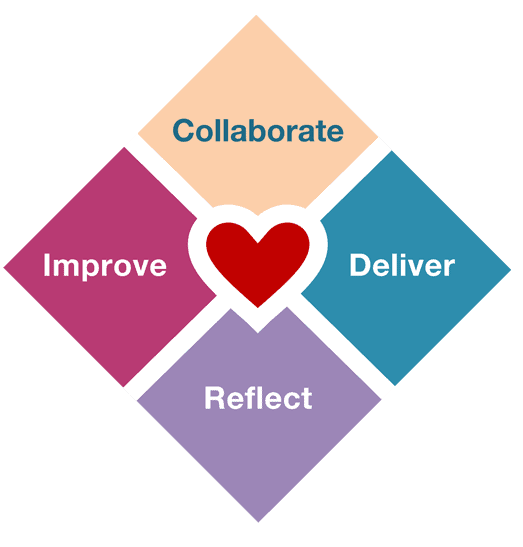Contents
Back to Basics: Understanding Agile Values
Last month I had the opportunity of attending “Ágiles Colombia”, the Colombian Conference on Agile frameworks that draws in attendees from all over Latin America. Typical of the Agile world, the conference had an open space format, one in which anyone can propose a talk and the schedule is self-organized.
After hearing all the proposals and elevator-pitches, I was more drawn to the talks that were related to soft skills and Agile values rather than the technical ones. Maybe it was because I was going through some changes in my personal life and I also needed to reconnect with my inner Agile values. So I ended up attending some talks that aimed at the “Being” instead of the “Doing”. I think that the ideas and perspectives are worth sharing, so that is what I’ll share with you in this post.
The importance of psychological safety
Psychological safety is the belief that one won’t be punished or humiliated for speaking up with one’s ideas, questions, concerns or mistakes. We are definitely in the era of the future of work where we’re dealing with less operative tasks and more artificially intelligent tasks that require more intellect, more purpose, and more collaboration. And to collaborate effectively, everyone should feel encouraged and motivated to chip in with ideas and take risks without the fear of having their heads cut-off. Mckinsey has also released some articles that backup the idea that the safer the work environment, the better the employee performance.
Jorge Silva, one of the speakers, mentioned some tips for fostering psychological safety:
- Lead by example: This means acknowledging our mistakes, being open to opinions that differ from ours and asking for feedback.
- Encourage active listening: This is important to ensure that people feel they can contribute to the team. This means paying attention in meetings, showing understanding and asking others for their opinion.
- Help people feel comfortable: Don’t interrupt, avoid judging ideas and never place blame.
- Create an open culture: Encourage different teams to give each other feedback.
This got me thinking: Am I really transmitting to my colleagues trust and openness so they can feel comfortable speaking their minds and making decisions? This made me think about the possibilities of Agile in one’s personal life as well… Are we creating a safe environment at home? Can our families give us feedback? Am I able to speak my mind in a constructive way to my loved-ones? This seems easier said than done, but creating psychological safety can bring a lot of value to our relationships.
Going back to Agile’s purpose
Pablo Mejía, another speaker, raised a thought-provoking question: When we eat something and we’re not really hungry, from which standpoint are we doing it? Is it purely out of gluttony? From anxiety? Am I in a meeting and eating is part of the ritual of socializing? From which point and with what intention am I doing something? What is the energy that moves me to do something?
Often, we start carrying out the Scrum processes in a semiautomatic way. We just take what the book says, the process that we have always followed, and just keep doing ceremonies and reviewing the team’s velocity. However, it’s important to remember why we do all those things; to identify the purpose behind all that. Are we really doing all of those things to improve? Or just because it’s part of the theory?
So, it might be valuable for the Scrum Master to take a moment with the team and go back to Scrum’s basics. One activity that could be performed is to sit with the team and review the purpose of each ceremony: the Refinement Meeting, Planning Meeting, Review, Retrospective, and the Daily Scrum. Try to answer together:
- What is this ceremony?
- Where is it done?
- When is it done?
- Who participates in it?
- And most importantly: Why is it done? What is the purpose behind it?
Answering these questions could help you identify if there are some team members that do not fully understand the objectives of a meeting, and it could shed light on some Scrum anti-patterns that could be happening in your Scrum workflow.
Be present here and now
I also participated in a couple of guided meditations and a talk about the Zen mind. All of these got me remembering the values behind Agile; not just the 4 stated in the Agile Manifesto, but all the values, soft-skills and behaviors that we should cultivate to improve in our facilitation tasks. The Zen mind is a way of being in the world, being present here and now. It means being open to acknowledging what I don’t know. This does not mean having a closed mind, but actually keeping it empty. When the mind is empty, it is always ready for anything, open to everything. Many possibilities are presented to the beginner’s mind; but to the expert’s, only a few. So, we went through the skills around openness.
The talk also invited us to pay attention to the person we are interacting with and to be aware of their context. This meant practicing the skills of attention and consciousness. We should be aware of the context of the people in our teams; normally the experiences they have lived end up defining them and explaining through which perspective they see the world.
As the speaker wisely said:
“Everything is related to something else. We are what we are thanks to all that has touched us. A rose is not just a rose; it is also a bit of sun, wind, earth, water and everything that allowed the rose to become a rose and bloom.”
So we should practice thankfulness towards our past experiences as well, for they have forged us also.
Getting back on track with Agile values
Alistair Cockburn, one of the authors of the Agile Manifesto and creator of The Heart of Agile, proposed an approach to get Agile back on track while recovering its simplicity by recognizing that it can be expressed in four words:

- Collaborate: To collaborate, we want to improve trust, motivation, and the act of collaboration. Cockburn suggests working on active listening, stepping forward, breaking down silos, creating a rewards program to favor motivation, delegating tasks and allowing failure.
- Deliver: Delivery has internal and external aspects. Internally, we find concepts such as incremental development, work-in-progress limits, kanban, and the work processes. Externally, we find delivery for revenue.
Delivering incrementally and often is well understood. But it is also important to bring the concept of delivering just to learn; to learn, for example, what market we should address and with what features, as well as learn how to work together.
- Reflect: Reflection is rarely done well. It’s important to explicitly stop and examine what’s happening before jumping to improvement initiatives. It should have two parts: gathering emotional information, usually about the team and the process, and objective information from data about the product.
- Improve: The “improve” arena means to experiment and change. Involve the team in the quest for solutions and options; pick one to test, and start the whole cycle of the heart again.
The Heart of Agile —as this approach is called— addresses attitudes and behavior directly. It doesn’t remove the complexities of daily life; it only acts as a reminder to try to think simple for a moment and go back to the basics.
Reconnecting with the Agile state of mind

Doing Agile could be somewhat easy. You could take the theory and start applying it with your teams. But we have to remember that Agile is more than that; you cannot really connect with the people in your team(s) if you do not believe in the values behind it. Those values could even end up being helpful in your personal life as well.
Even though the topics of the talks didn’t directly explain the Agile theory or process, they relate to our well-being and the Agile state of mind to help us perform better on a daily basis in this fast-paced world. Have you found other valuable ways to cultivate your soft-skills? Let us know in the comments below! Also, feel free to share this article with your colleagues and start new discussions around the Agile topic.



